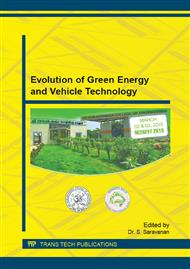[1]
M.A. Shalaby, M.A. Elhakim, Magdy M. Abdel Hameed. b, J.E. Kiranowski, S. CVeldhis, G.K. Dosbaeva, Wear mechanism of several cutting tool materials in hard turning of high carbon chromium tool steel, Tribol. Int. 70(2014)148-154.
DOI: 10.1016/j.triboint.2013.10.011
Google Scholar
[2]
A. Vereschaka,M. Volosova,S. Grigoriev,A. Vereschaka, Development of wear-resistant complex for High speed steel tool when using process of combined cathodic vacuum arc deposition, Procedia CIRP. 9(2013) 8-12.
DOI: 10.1016/j.procir.2013.06.159
Google Scholar
[3]
Ivan povstugar, Pyuck-pa Choi, Darius Tytko, Jae-pyeong Ahn, Dierk Raabe, Interface-directed spinoidal decomposition in TiAlN/CrN multilayer hard coatings studied by atom probe tomography, Acta Mater. 61 (2013)7534-7542.
DOI: 10.1016/j.actamat.2013.08.028
Google Scholar
[4]
S. Lamri,C. Langlade,G. Kermouche, Damage phenomena of thin hard coatings submitted to repeated impacts: Influence of the substrate and film properties, Mater. Sci. Eng., A. 560(2013)296-305.
DOI: 10.1016/j.msea.2012.09.070
Google Scholar
[5]
Roland Haubner, The history of hard CVD coatings for tool Applications at the university of Technology Vienna, Int.J. Refract. Met. Hard Mater. 41(2013)22-34.
DOI: 10.1016/j.ijrmhm.2013.01.012
Google Scholar
[6]
T. Schmidtova,P. Soucek,V. Kudrle,P. Vasina, Non-monotonous evolution of hybrid PVD-PECVDNprocess characteristics on hydrocarbon supply, Surf. Coat. Technol. 232(2013)283-289.
DOI: 10.1016/j.surfcoat.2013.05.014
Google Scholar
[7]
Manabu Yasuoka, Pangpang Wang, Ri-ichi Murakami, Comparison of the mechanical performance of cutting tools coated by either a TiCxN1−x single-layer or a TiC/TiC0. 5N0. 5/TiN multilayer using the hollow cathode discharge ion plating method, Surf. coat. Technol. 206(2012).
DOI: 10.1016/j.surfcoat.2011.09.053
Google Scholar
[8]
S. Lamri,C. Langlade,G. Kermouche. Damage phenomena of thin hard coatings submitted to repeated impacts. Influence of the substrate and film properties. Mater. Sci. Eng., A. 560 (2013) 296–305.
DOI: 10.1016/j.msea.2012.09.070
Google Scholar
[9]
V. Zavaleyeva,J. Walkowicz,G. Greczynski,L. Hultman, Effect of substrate temperature on properties of diamond-like films deposited by combined DC impulse vacuum-arc method, Surf. coat. Technol. 236(2013) 444 -449.
DOI: 10.1016/j.surfcoat.2013.10.023
Google Scholar
[10]
J.J. Roa, E. Jimenez-Pique,R. Martinez,G. Ramirez J.M. Tarrago,R. Rodriguez, LIanes. Contact damage and fracture micromechanisms of multilayered TiN/CrN Coatings at micro- and nano-length scales, Thin solid films. xxx(2014)xxx-xxx.
DOI: 10.1016/j.tsf.2014.04.018
Google Scholar
[11]
Han joo Choe, Soon-Ho Kwon, Jung-Joong Lee, Tribological properties and thermal stability of TiAlCN coatings deposited by ICP-assisted sputtering, Surf. coat. Technol. 228(2013)282-285.
DOI: 10.1016/j.surfcoat.2013.04.041
Google Scholar
[12]
Theo Sinkovits, Yue Zhao, Rebecca O Brien, Steve Dowey. X-ray diffraction stress analysis of interrupted titanium nitride films: Combining the sin2ψ and crystallite group methods, Thin solid Films. xxx(2014)xxx-xxx.
DOI: 10.1016/j.tsf.2014.04.054
Google Scholar
[13]
Kulwant Singh, N. Krishnamurthy, A.K. Suri, Adhesion and wear studies of magnetron sputtered NbN films, Tribol. Int. 50 (2012) 16–25.
DOI: 10.1016/j.triboint.2011.12.023
Google Scholar
[14]
Chung-Soo Kim, Sung-Hoon Ahn, Dong-Young Jang. Review: Developments in micro/nanoscale fabrication by focused ion beams, Vacuum. 86(2012)1014-1035.
DOI: 10.1016/j.vacuum.2011.11.004
Google Scholar
[15]
www. mfg. mtu. edu.
Google Scholar


